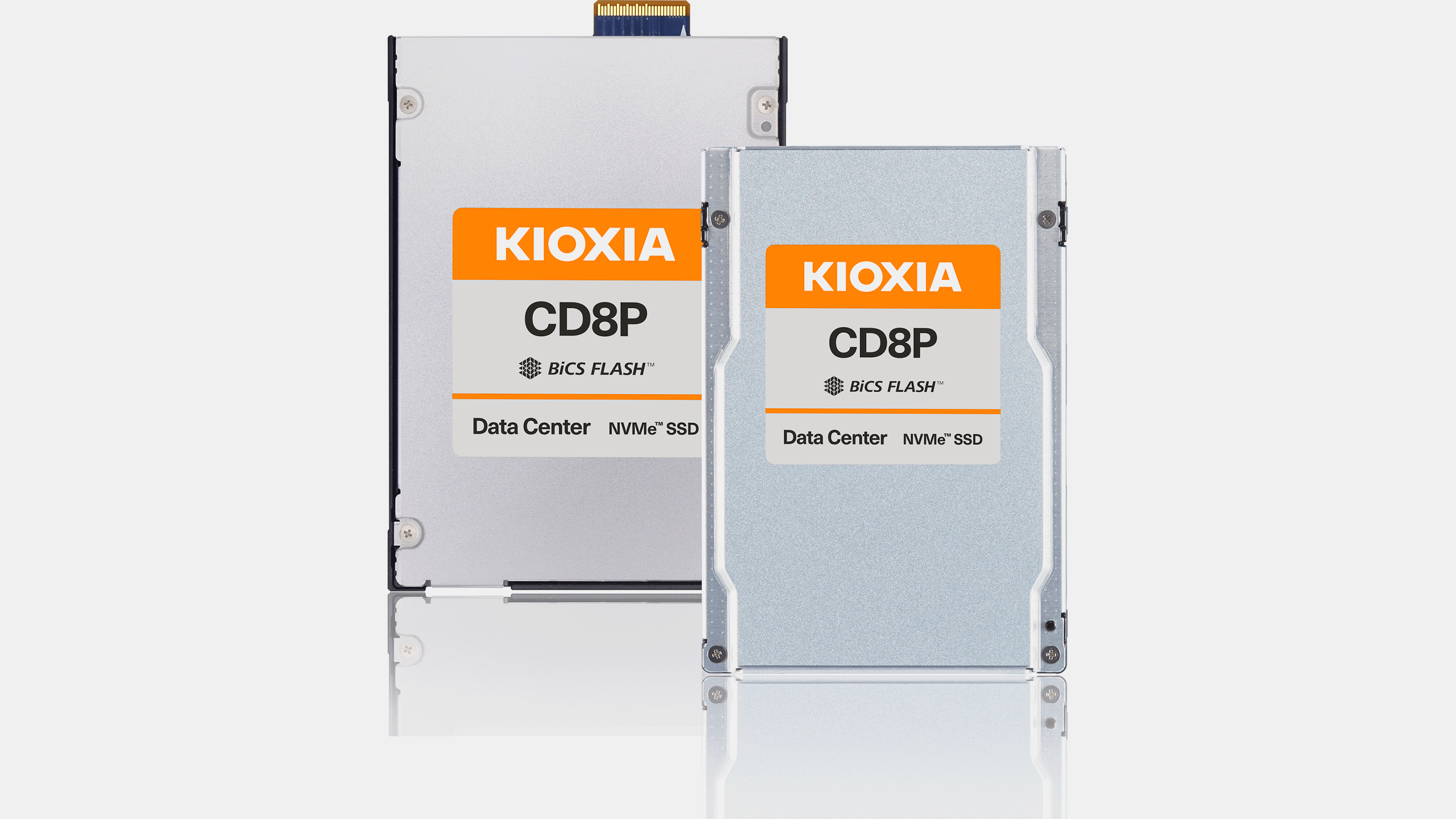Kioxia Launches 30TB SSD with a PCIe 5.0 x4 Interface
Kioxia's CD8P SSDs for hyperscalers combine performance and capacity.

Kioxia on Monday introduced one of the industry's first families of solid-state drives for hyperscalers featuring a PCIe 5.0 x4 interface and capacities of up to 30.72TB. The CD8P line-up of SSDs is designed for mixed use and read intensive workloads and feature all the reliability features that one comes to expect from datacenter-grade SSDs designed to work for 24/7.
Kioxia's single-port CD8P solid-state drives come in E3.S and U.2 form-factors and offer a wide range of capacities starting at 1.6 TB and ending at 30.72 TB. As for performance, the manufacturer rates the drives at up to 12,000 MB/s sequential read speed, up to 5,500 MB/s sequential write speed, up to 2,000,000 random read 4K IOPS, and up to 400,000 random write 4K IOPS.
The new drives are a bit slower than enterprise-grade CM7 SSDs launched a year ago. Those drives are designed for enterprise workloads and have different performance (up to 14,000 MB/s) and feature set requirements (e.g., dual-port, FIPS SED).

The new CD8P SSDs use Kioxia's proprietary SSD platform consisting of its own NVM 2.0-compliant controller, firmware, and 112-layer BICS 5 3D TLC NAND memory that supports the company's 7th Generation flash die failure protection to ensure reliable data storage, power loss protection, and end-to-end data protection. In addition to regular CD8P models, Kioxia will also offer SKUs supporting Sanitize Instant Erase (SIE) and Self-Encrypting Drive (SED) capabilities. Meanwhile, CD8P will not be available with FIPS SED capability.
It should ne noted that Kioxia will offer its CD8P SSDs in two types of configurations: the CD8P-V for mixed-use workloads (up to three drive writes per day) will come with 1.60 TB, 3.20 TB, 6.40 TB, and 12.8 TB capacities, whereas the CD8P-R for read-intensive applications (up to one drive writes per day) will be offered in 1.92 TB, 3.84 TB, 7.68 TB, 15.36 TB, and 30.72 TB capacities.
While Kioxia is introducing its new CD8P SSDs at the Flash Memory Summit and plans to show them up and running at the show, it does not disclose when these drives are set to be available. Given that they are aimed mostly at hyperscalers, Kioxia will ship them once its customers validate and qualify them in their environments.
Get Tom's Hardware's best news and in-depth reviews, straight to your inbox.

Anton Shilov is a contributing writer at Tom’s Hardware. Over the past couple of decades, he has covered everything from CPUs and GPUs to supercomputers and from modern process technologies and latest fab tools to high-tech industry trends.
-
DavidLejdar Somewhat tempting already. But as it turned out, I would need to scale up my RAM first. Recording a gaming video at 1440p and 60 FPS, with a bitrate aimed at quality (and not streaming), after about two hours the file hits 32+GB - and that makes it somewhat complicated to load the file for editing when the RAM doesn't have more than that.Reply
There may be editing software, which loads file parts as needed, of course. But just meaning to point out that these SSDs are now scaling up to an extent, where other PC parts are lacking, such as in regard to RAM capacity, or GPU processing power (when one does have an intensive data usage scenario). -
Atom11 SSDs are scaling exactly like they have in the past, like 2008 where 80GB cost $595, or 1989 where 1MB cost over $1,000. SSD prices are cut in half every 2 years, and this trend has not been broken as of 2023. I'm an owner of a Micron 9400 Pro U.3 30TB SSD that is going for €3,200 as of July 2023.Reply
If the current trend continues you will be able to buy a 256TB SSD for $1,500 in 2033.
@DavidLejdar If you are lacking PC parts, you need to upgrade, the RTX 4090 should be fast enough for everything you can do, and installing 128GB of RAM is not a big deal in 2023. How big your SSD is has nothing to do with your other PC parts.